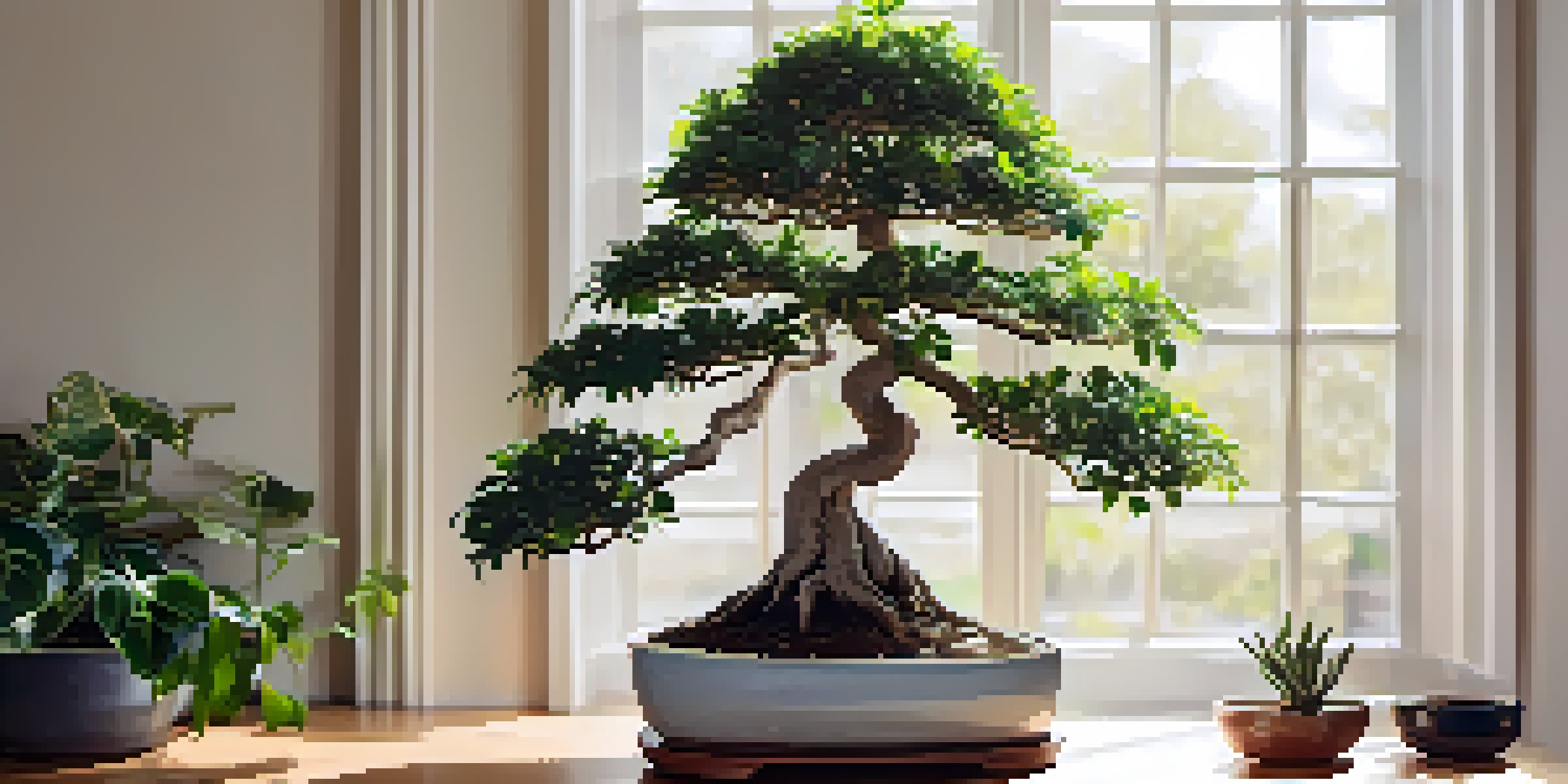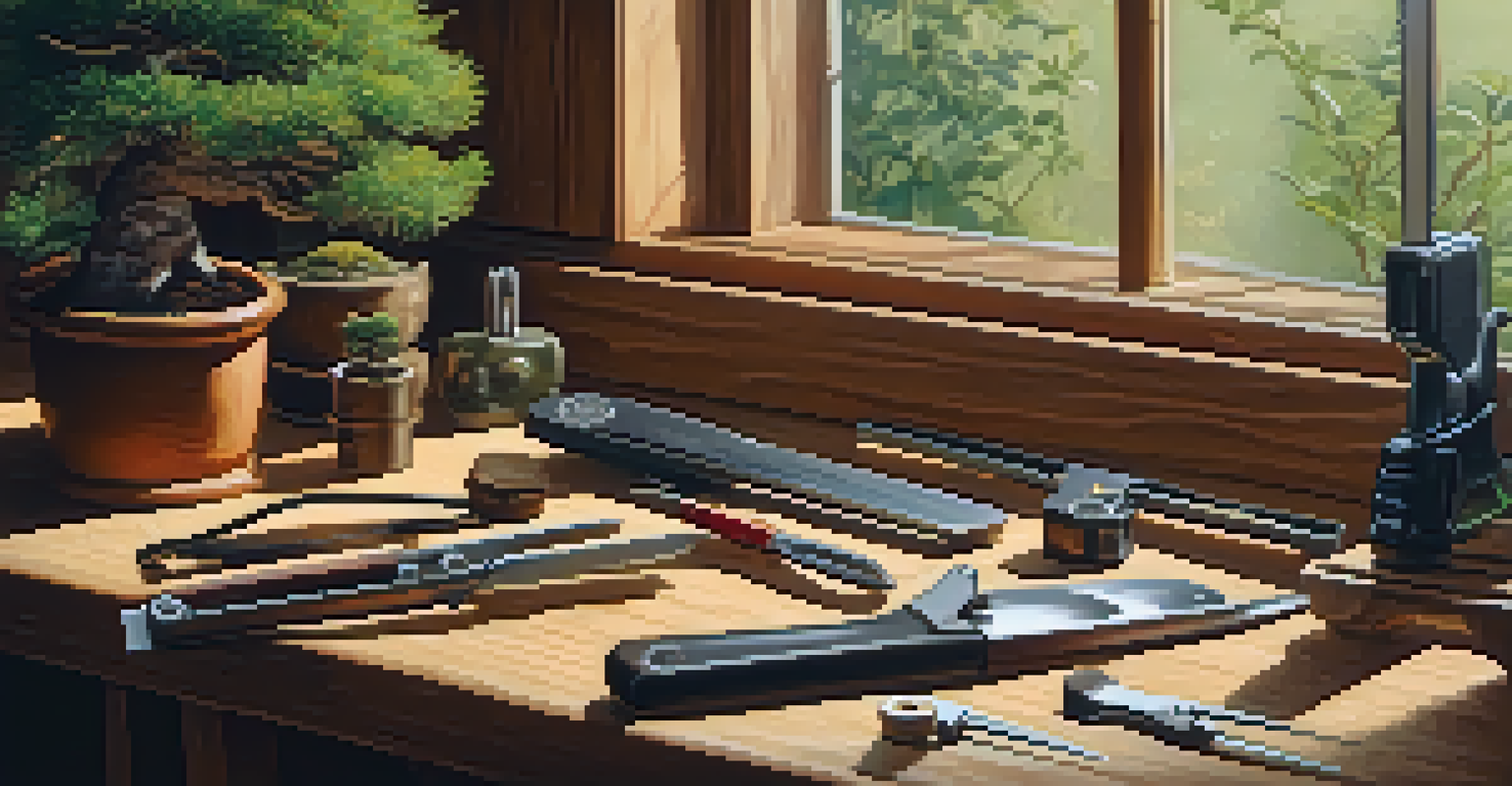Bonsai for Beginners: A Step-by-Step Cultivation Guide

Understanding the Basics of Bonsai Cultivation
Bonsai is more than just a miniature tree; it's an art form that requires patience and dedication. The word 'bonsai' translates to 'planted in a container,' which emphasizes the care and technique involved in shaping these plants. By mastering the basics, you can create stunning designs that not only showcase nature's beauty but also reflect your personal style.
The more you know, the more you realize you know nothing.
To start your bonsai journey, it's essential to understand the different types of bonsai trees available. Popular choices for beginners include Ficus, Juniper, and Chinese Elm. Each species has unique growth habits and care requirements, so selecting the right one for your environment and experience level is crucial.
Finally, familiarize yourself with the key techniques involved in bonsai cultivation, such as pruning, wiring, and repotting. These techniques will help you shape your tree and maintain its health over time, ensuring a thriving bonsai that can be enjoyed for years to come.
Choosing the Right Bonsai Tree for You
When selecting your first bonsai tree, consider factors such as climate, indoor vs. outdoor placement, and your level of commitment. For indoor bonsai, species like Ficus are wonderful choices due to their resilience and adaptability. Conversely, if you’re leaning towards an outdoor bonsai, trees like Juniper or Maple can thrive beautifully outside.

It's also helpful to visit a local nursery or bonsai specialty shop to see the trees in person. This allows you to inspect the overall health of the plant and ask questions to knowledgeable staff. Plus, choosing a tree that catches your eye can make the cultivation process even more enjoyable.
Master the Basics of Bonsai Care
Understanding the essential techniques like pruning, wiring, and repotting is crucial for cultivating a healthy and beautiful bonsai.
Lastly, remember that some species may require more care than others. If you're a beginner, opt for a tree that’s known for being forgiving, as this will give you the confidence to learn and grow as a bonsai caretaker.
Essential Tools for Bonsai Cultivation
Investing in the right tools is key to successful bonsai cultivation. Basic tools include pruning shears, wire for shaping, and a quality soil mix designed for bonsai. These tools help you maintain your tree's health and shape it as you envision.
Nature does not hurry, yet everything is accomplished.
Pruning shears are vital for trimming leaves and branches, promoting healthy growth and keeping your tree’s shape. Wiring tools allow you to bend and train branches into desired positions, giving your bonsai its unique form. With these essential tools in hand, you’ll be well-prepared to nurture your bonsai.
Additionally, consider investing in a moisture meter to help monitor your tree's water needs. This will help prevent overwatering or underwatering, which are common pitfalls for beginners. Having the right tools not only makes the process easier but also enhances your overall bonsai experience.
Pot Selection: Finding the Right Container
Choosing the right pot is crucial for your bonsai’s health and aesthetic appeal. Bonsai pots come in various shapes, sizes, and materials, each serving a specific purpose. A well-chosen pot can enhance the beauty of your tree while providing the necessary drainage and support.
Look for pots with drainage holes to prevent water from pooling at the bottom, which can lead to root rot. The size of the pot should be proportionate to the tree; a pot that's too large can hinder growth while one that's too small can restrict roots. Finding a balance is essential for a thriving bonsai.
Choose the Right Bonsai Tree
Selecting a bonsai tree that fits your climate and care level enhances your chances of successful cultivation.
Lastly, consider the style and color of the pot as it should complement your bonsai's design. A minimalist ceramic pot can highlight the tree's beauty, while a rustic wooden container can add an earthy touch. The right pot not only supports your tree but also tells a story about your bonsai journey.
Watering Your Bonsai: Striking the Right Balance
Watering is one of the most critical aspects of bonsai care, and finding the right balance can be tricky. Overwatering can suffocate roots, while underwatering can lead to wilting. A good rule of thumb is to check the soil moisture regularly; when the top inch feels dry, it’s time to water.
Different tree species have varying water needs, so it's essential to understand the requirements of your specific bonsai. Factors such as climate, pot size, and season also influence how often you should water. For example, trees may need more frequent watering during hot summer months compared to cooler seasons.
Always water your bonsai thoroughly, allowing water to drain from the bottom of the pot. This ensures the entire root system receives moisture. With practice, you'll develop a keen sense of your bonsai's needs, creating a thriving environment for your miniature masterpiece.
Pruning and Shaping Your Bonsai Tree
Pruning is essential for maintaining your bonsai's shape and promoting healthy growth. Regular pruning encourages new growth and helps you control the tree's size. Start by trimming away any unnecessary leaves or branches, focusing on maintaining a balanced structure.
Wiring is another technique used to shape your bonsai. By wrapping wire around branches, you can bend them into desired positions. Be careful not to apply too much pressure, as this can damage the tree. It's a delicate dance between creativity and care, but with practice, you’ll master the art of shaping.
Essential Tools for Bonsai Success
Investing in the right tools, such as pruning shears and quality soil, is key to maintaining your bonsai's health and shape.
Remember to step back and evaluate your work periodically. This allows you to see how your design is progressing and make adjustments as needed. With patience and practice, your bonsai will develop into a stunning representation of your vision.
Repotting: Ensuring Your Bonsai's Continued Growth
Repotting is an essential aspect of bonsai care, allowing you to refresh the soil and provide your tree with more room to grow. Typically, bonsai trees should be repotted every couple of years, depending on their growth rate and the size of the pot. This process helps prevent root binding and ensures your tree has access to fresh nutrients.
When repotting, carefully remove the tree from its pot and inspect the roots. Trim any that are overly long or damaged, as this encourages new growth. Be sure to use a well-draining soil mix specifically designed for bonsai, as this will help maintain the right moisture balance.

After repotting, place your bonsai in a shaded area for a few weeks to let it adjust to its new environment. With proper care, your bonsai will thrive in its new home, allowing you to enjoy its beauty for years to come.